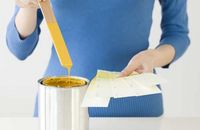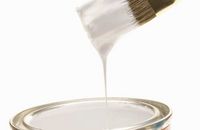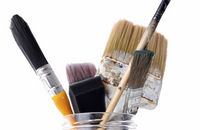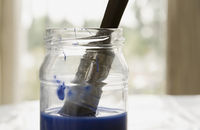By Kirstie Allsopp
You Will Need
Different paint colours of the same finish (in other words, all emulsion, all satin or all gloss)
White paint of same finish (optional)

Step One: Experiment To Understand Mixing
Start by experimenting with small quantities of paint, bearing colour theory in mind. For example, primary colours are red, yellow and blue. Mix two of these and you'll create a secondary colour: orange, green or purple.
Bear in mind that you can also mix a primary colour with a secondary shade that does contain the primary, for example lime green is yellow added to a mix of yellow and blue.
Start by experimenting with small quantities of paint, bearing colour theory in mind. For example, primary colours are red, yellow and blue. Mix two of these and you'll create a secondary colour: orange, green or purple.
Bear in mind that you can also mix a primary colour with a secondary shade that does contain the primary, for example lime green is yellow added to a mix of yellow and blue.

Step Two: Keep Track Of What You Add
To lighten the colour you come up with, add white; add black and get a darker version of your original colour.
Keep track of the ratio and quantities of paint you’ve used to create your preferred shade.
To lighten the colour you come up with, add white; add black and get a darker version of your original colour.
Keep track of the ratio and quantities of paint you’ve used to create your preferred shade.

Step Three: Test The Paint
If you've come to a colour you're happy with, try it out on a sheet of paper or an inconspicuous area of whatever you're painting.
Let it dry before making a judgement. Dry paint reflects light differently, so the colour you love in a wet mixture won't be the same when it's dry.
If you've come to a colour you're happy with, try it out on a sheet of paper or an inconspicuous area of whatever you're painting.
Let it dry before making a judgement. Dry paint reflects light differently, so the colour you love in a wet mixture won't be the same when it's dry.

Step Four: Recreate The Colour
Recreate the colour you like, this time in greater quantity, making up enough to complete the whole job.
Bear in mind that it might be impossible for you to mix exactly the right shade again, so if you don't think you'll have enough paint to cover the area, play safe and get your paint mixed professionally.
Recreate the colour you like, this time in greater quantity, making up enough to complete the whole job.
Bear in mind that it might be impossible for you to mix exactly the right shade again, so if you don't think you'll have enough paint to cover the area, play safe and get your paint mixed professionally.

0 komentar:
Post a Comment